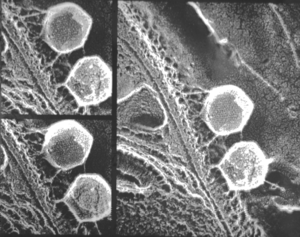Phycodnaviridae: Difference between revisions
No edit summary |
No edit summary |
||
| Line 1: | Line 1: | ||
[[Image:phycodna.gif|thumb|right|Phycodnaviridae. From [http://www.ncbi.nlm.nih.gov/ICTVdb/ICTVdB/51000000.htm ICTVdB Descriptions]]] | |||
==Baltimore Classification== | ==Baltimore Classification== | ||
Revision as of 15:25, 28 June 2006

Baltimore Classification
Higher order taxa
Viruses; dsDNA viruses, no RNA stage; Phycodnaviridae
Genera
Chlororvirus, Coccolithovirus, Phaeovirus, Prasinovirus, Prymnesiovirus
Description and Significance
Phycodnaviridae are viruses with double-stranded DNA that infect chlorella, algal symbionts of paramecia and hydras.
Genome Structure
The genome of phycodnaviridae is not segmented and contains a single molecule of linear double-stranded DNA. The complete genome is 250000-350000 nucleotides long. The genome guanine+cytosine content is 40-52 %. The genome contains unusual bases, varying from 0.1-47 %. These bases are 5-methyl deoxy-cytosine residues and N6-methyl deoxy-adenosine residues in some DNAs. The double-stranded DNA is non-permuted and the genome sequence has termini with cross-linked hairpin ends. The genome, except for the hairpin, has terminally redundant sequences. These sequences have inverted terminal repetitions (ITR) for at least 2000 bases. (source: ICTVdB Descriptions)
The virions of phycodnaviridae consist of a non-enveloped capsid. The virion attaches to the host cell surface and releases DNA into the host cell in a similar fashion as Tectiviridae. The capsid is round and exhibits polyhedral symmetry. The isometric capsid has a diameter of 130-200 nm. The capsid shells of virions are composed of multiple layers and are referred to as multilaminated capsids. The capsids appear hexagonal in outline. (source: ICTVdB Descriptions)
